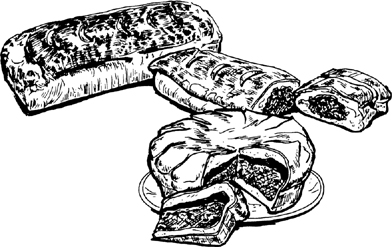Mastering the Art of French Cooking, Volume 2 (128 page)
Read Mastering the Art of French Cooking, Volume 2 Online
Authors: Julia Child

For liver spread or pâté
The basic chicken-liver mixture
4 ounces (½ cup) softened butter
4 ounces (½ cup) cream cheese
Purée liver mixture through a food mill, meat grinder, or blender, then beat in softened butter and cream cheese. Correct seasoning. If you plan to use this as a
pâté,
pack into a covered jar or mold, and chill.
For farce à gratin—to use as a spread, filling, or pâté
The basic chicken-liver mixture but substitute: 6 ounces (¾ cup) fresh pork fatback or outside loin fat for the butter
Rather than using butter for cooking the onions and chicken livers, use the ¾ cup pork fat as follows: grind or mince it, and cook slowly for 8 to 10 minutes in the sauté pan until pieces of fat are translucent but not browned, and ⅓ cup or so of fat has rendered.
Then proceed with the recipe. Purée in a blender, food mill, or meat grinder, pack into a jar or decorative bowl, and chill.
(*)
STORAGE NOTE
: Any of these will keep for 4 to 5 days in the refrigerator, and they freeze successfully for several months.
SAUSAGES AND OTHER MEAT MIXTURES BAKED IN
BRIOCHE
DOUGH
Saucissons et Pâtés en Brioche
When you want to be dramatic and dressy with sausage, bake it in a
brioche
case. For cocktails, slice it warm and thin and serve on little plates. When it is a hot first course or the mainstay for luncheon or supper, include a succulent brown sauce to pour over each serving. Although reminiscent of
pâté en croûte,
sausage in
brioche
is usually served warm, and is lighter in general impression. Unlike the real
pâté,
which goes raw into its covering of dough for baking, the sausage or meat mixture that is enclosed in
brioche
dough has already been cooked, and remains in the oven only long enough to heat through as the
brioche
bakes.
FORMING NOTE
The rectangular loaf shape that encloses a large cylindrical sausage is the most typical form, and the one we shall illustrate. With your own sausage or cooked meat mixture, however, you may make it round, square, heart-shaped, or whatever you wish.
CLOSING THE GAP
Because you are working with live dough, that is, yeast dough, you may run into one problem that does not occur with pastry dough: this is a sometimes ugly space between the meat and the
brioche
that only reveals itself when you are slicing through the structure to serve.
It is particularly true of home-cured or store-bought sausages, less true of soft mixtures like chicken livers, and more liable to be troublesome with sausages
baked in a pan
than with those formed
on a pastry sheet
. One way to minimize the gap or eliminate it completely is to be sure that the sausage is very hot at the moment you enclose it in the dough. Heat kills the yeast in a thin layer of dough, about ⅛ inch, all around the sausage, and this layer should cling to the sausage while the rest of the dough rises around it. Another way to close the gap is to bake the sausage in a closed pan, as suggested in a variation at the end of the Master Recipe. We are only giving prominence to this problem so that you will be aware of it and pleased with yourself when you have avoided it but not unduly disturbed when you have not. In such instances, however, when you want to serve a cold liver
pâté en brioche,
you will welcome the gap because you can siphon a deliciously flavored aspic into that space between meat and
brioche,
which will add immensely to the taste and appearance of the
pâté
slices when you serve them.
TIMING NOTE
With your
brioche
dough made the day before, and your sausage or meat mixture ready for pre-cooking, you should count on 2½ to 3½ hours from the time you start the process until the time you can serve. You will need 40 minutes for poaching, if you are using a sausage, an hour for the dough-with-sausage to rise before baking, an hour for baking, and 20 to 30 minutes for meat and
brioche
to settle before slicing. Remember that you can control the
rising of dough
, and you can keep the baked result warm; thus you may arrange your schedule as you wish.

SAUCISSON EN BRIOCHE
[Sausage Baked in
Brioche
Dough]
This is for a large sausage about 12 inches long and 1½ to 2 inches in diameter, such as the
saucisson à cuire
and the liver or
foie gras
sausage following it, or for a store-bought sausage that is to be cooked and served hot, like a Polish sausage (
kielbasa
) or Italian
cotechino.
You may also use the cooked
chicken-liver sausage mixture
; in this case, omit Step 2 in the following recipe.
For a 12-inch case, serving 6 as a hot first course, 4 as a main course, or 18 slices for a cocktail appetizer
1)
The brioche dough—started the day before you plan to serve
Either
the
pain brioché
dough
;
Or
the
richer
pâte à brioche fine
(proportions for ½ lb. flour in either case)
Make the
brioche
dough, giving it one rise at room temperature and a second rise that finishes in the refrigerator. Dough must be well chilled before you form it in Step 3.



